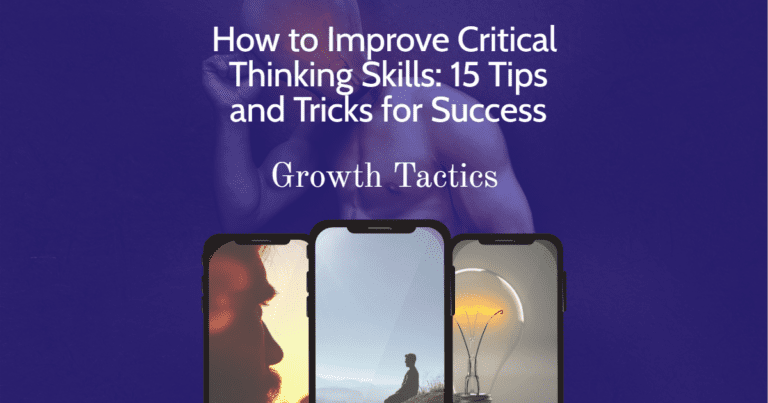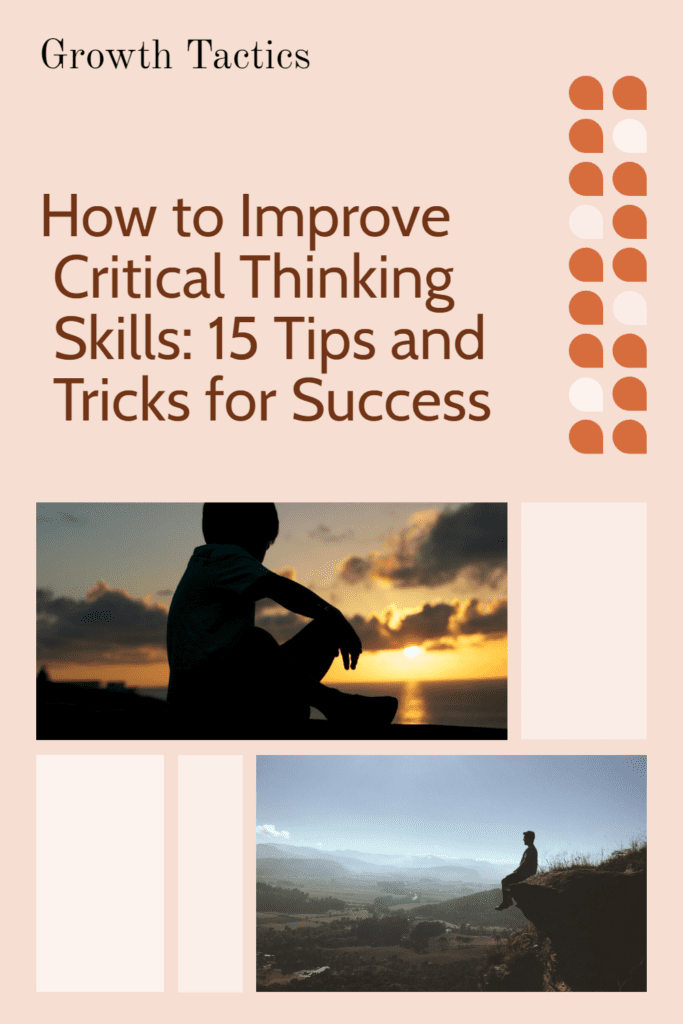In our fast-changing world, thinking carefully and making smart choices are vital. Welcome to our guide on how to develop your critical thinking skills.
We’ll share expert advice and fun activities to help you make good decisions, solve problems, and understand complex ideas. Join us on this exciting adventure and see your critical thinking skills grow, making life easier and more successful.
Jump To Section
What Are Critical Thinking Skills?
What does it mean to be a critical thinker? Let’s find out.
Understanding the Basics
Critical thinking is a way of thinking. It helps us make good choices. We look at the information carefully. Then, we decide what to believe or do.
Key Skills
There are several skills that help us think critically. Here are a few:
- Analyzing: We look at things closely. We break them into parts. This helps us understand them better.
- Evaluating: We think about the good and bad parts. We decide if something is useful or not.
- Problem-solving: We find ways to fix problems. We think of different solutions. Then, we choose the best one.
- Decision-making: We choose between options. We think about the pros and cons. This helps us make the best choice.
Why Are Critical Thinking Skills Important?
Critical thinking skills are important. They help us in school, work, and life. We can make better choices. We can solve problems faster. We can understand complex ideas.
Now you know what critical thinking skills are. Keep reading to learn how to improve them.
How to Develop Critical Thinking Skills

Ask Questions
Asking questions is an effective way to improve your critical thinking skills. When you ask questions, you’ll be able to understand things better, find new ideas, and see problems from different angles.
How to Ask Good Questions
Asking good questions is the first step toward improving critical thinking skills. Here are some tips on how to do it:
- Be curious. Ask yourself what you don’t know, and then go find out!
- Keep it simple. Don’t get caught up in details at this point; just focus on getting a general sense of the situation and looking for patterns or problems that need fixing.
- Be open-minded. Don’t assume you know everything about a subject before starting an investigation–you might be surprised by what you find!
- Ask “Why?” A lot of times when we ask ourselves why something happened or happened this way instead of another way, we come up with new ideas for solving problems or improving our lives in general (and sometimes even get answers).
Examples of Questions to Ask
- What is the main point?
- Why does this matter?
- How can I use this information?
- What if I try a different approach?
- Can you explain in simpler words (or with an example)?
Active Listening: Your Secret Weapon
Want better critical thinking skills? Try active listening. It helps you understand others and learn new things.
Why Active Listening?
Active listening helps you:
- Understand different perspectives
- Make better decisions
- Build stronger relationships
How to Practice Active Listening
Follow these steps to become an active listener:
- Focus: Give the speaker your full attention. Avoid distractions.
- Reflect: Repeat or paraphrase what the speaker says. This shows you’re engaged.
- Encourage: Use body language and gestures to show you’re listening.
- Don’t interrupt: Wait for the speaker to finish before asking questions or adding your thoughts.
- Ask questions: Clarify points and show your interest in what’s being said.
Reflect on Your Thoughts: The Power of Self-Analysis
Want to make better decisions? Think about your thinking. Analyzing your logic and the reasons behind it can help you improve this skill.
Why Reflect on Your Thoughts?
Reflection helps you:
- Understand your decisions
- Recognize biases
- Learn from past experiences
How to Reflect on Your Thoughts
Here are some tips for self-reflection:
- Set aside time: Schedule quiet moments for reflection.
- Write it down: Journaling helps you organize and analyze your thoughts.
- Ask yourself questions: Why did I make this decision? What influenced my beliefs?
- Be honest: Admit any biases or mistakes you’ve made.
- Learn from it: Apply your insights to future decisions.
Embrace Diverse Perspectives

One of the best ways to improve your critical thinking skills is by embracing diverse perspectives.
When you’re working with a team, it’s important to understand the different points of view that each member brings to the table. When you’re dealing with clients or customers, it’s crucial that they feel heard and respected and this can only happen when everyone feels like they have an equal voice in the conversation.
To get started with this practice, try asking yourself: “What would someone else think?” This question will help open up new avenues of thought for any situation, whether it’s something as simple as buying groceries at the grocery store or making decisions about where your company should go next year for its annual conference (or even just deciding what movie night snacks are going on tonight).
How to Embrace Diverse Perspectives
- Listen actively
- Respect others
- Learn from others
Cultivate a Desire to Learn: Exploring New Ideas and Perspectives
Cultivating a desire to learn is essential for personal growth. It helps you stay engaged, adapt to change, and become a more well-rounded individual. Let’s explore how you can develop this lifelong learning mindset.
Embrace Curiosity
First, embrace curiosity. Ask questions, listen actively, and approach new subjects with an open mind. This mindset will enhance your understanding of the world and foster personal growth.
Diversify Your Interests
Next, diversify your interests. Explore topics outside your comfort zone by reading books, attending workshops, or watching documentaries. This practice will spark fresh insights and knowledge.
Connect with Others
Lastly, connect with people from different backgrounds. Engaging in conversations with diverse individuals will help you appreciate alternative viewpoints and improve your communication skills.
Engaging in Opposing Viewpoint Discussions: Sharpen Your Critical Thinking
Participating in discussions with opposing viewpoints can greatly enhance your critical thinking skills. Let’s explore the benefits of engaging in these conversations and how they can refine your arguments.
Boost Critical Thinking
Engaging with opposing viewpoints challenges your beliefs. This process helps you analyze your own ideas, identify flaws, and ultimately boost your critical thinking skills.
Refine Your Arguments
Debating with others who hold different opinions encourages you to refine your arguments. You’ll learn to present your ideas more clearly, persuasively, and logically.
Foster Empathy
Listening to opposing viewpoints fosters empathy. Understanding others’ perspectives, even if you disagree, helps build stronger relationships and better communication.
Read Widely
Consuming a variety of materials is an important step in the creative process. It’s not enough to just read one type of book or listen to one kind of music; you need exposure to different ideas and information if you want your brain to be able to make connections between them.
The more diverse your consumption habits are, the more likely it is that you’ll stumble upon something new and exciting–even if it’s not what you were looking for!
Benefits of Consuming a Variety of Materials
- Exposure to different ideas.
- Gain new perspectives.
- Broaden your knowledge base.
Types of Materials
There are many different types of materials that you can consume. Some of the most common include books, articles, reports, magazines, and podcasts. If you want to be exposed to a wide variety of ideas and information then it’s important that you consume these different types of media.
Finding New Materials
- Search engines: You can search for materials on Google, Bing, and other search engines.
- Social media: You can use social media to find new information and resources. For example, you could use Twitter or Facebook to see what people are talking about in your industry or community. Or you could join LinkedIn groups related to your field of work so that you can stay up-to-date on industry trends and news stories related to your career interests.
- Libraries: Libraries contain bookshelves full of all kinds of information about different topics–from history books about ancient civilizations all the way up through current events magazines from today’s newspapers! Check out those shelves next time you visit one (and maybe even ask someone behind the desk if they have any recommendations).
- Bookstores: Bookstores also sell lots of printed material–so if there isn’t anything interesting enough at home already then why not check out some stores nearby? They might even have some cool deals going on right now too!
Simplifying Complicated Issues: Break Them Down into Smaller Parts
Problems and issues often appear overwhelming at first glance. However, by breaking them down into smaller, more manageable parts, you can tackle them more effectively. In this blog section, we’ll explore some strategies to help you simplify complicated issues.
1. Identify the Core Problem
To simplify a complicated issue, start by identifying the core problem. Determine what the main concern is, and focus your attention on that. This will help you avoid getting bogged down in unrelated details.
2. Divide and Conquer
Once you’ve identified the core problem, break it down into smaller, more manageable parts. You can do this by categorizing the problem into subtopics or by focusing on specific aspects of the issue.
For example, if you’re dealing with a complex business problem, you can break it down into categories like finance, marketing, and operations. By tackling each category separately, you can better understand and address the overall issue.
3. Prioritize Tasks
With the problem broken down into smaller parts, prioritize the tasks that need to be accomplished. Determine which tasks are most critical or time-sensitive, and focus on those first. This will help you make progress and avoid feeling overwhelmed.
Visualizing Connections with Mind Mapping: Organize Your Thoughts and Improve Understanding
Mind mapping is a powerful tool that can help you visualize connections between ideas and concepts. It allows you to organize your thoughts in a way that makes them easier to understand and remember. In this blog section, we’ll discuss the benefits of mind mapping and provide some tips on how to create effective mind maps.
The Benefits of Mind Mapping
Mind mapping offers several advantages when it comes to organizing thoughts and ideas:
- Enhances memory and retention
- Boosts creativity
- Improves problem-solving skills
- Facilitates clear communication
- Encourages efficient brainstorming
How to Create a Mind Map
Creating a mind map is a simple and intuitive process. Follow these steps to get started:
Step 1: Start with a Central Idea
Begin by identifying the central idea or concept that you want to explore. Write it down in the center of your paper or digital canvas and draw a circle around it.
Step 2: Add Branching Ideas
Think of related ideas or subtopics that connect to the central idea. Draw lines extending outward from the central idea, and write these branching ideas along the lines. These branches can represent categories, themes, or questions related to the main concept.
Step 3: Expand with Sub-branches
Continue to expand your mind map by adding more sub-branches connected to the branching ideas. This can include specific examples, facts, or further questions related to each subtopic. The process helps build a visual hierarchy of information, making it easier to see the connections between different concepts.
Step 4: Use Colors and Images
Enhance your mind map by using colors to differentiate between branches or sub-branches. Adding images or symbols can also help make the map more visually engaging and memorable.
Embracing New Ideas: Overcoming Biases and Preconceived Notions

Being receptive to new ideas is crucial for personal and professional growth. It can be challenging, however, to set aside personal biases and preconceived notions. In this blog section, we’ll discuss the importance of open-mindedness and provide tips on how to embrace new ideas.
The Importance of Open-mindedness
- Remaining open to new ideas offers numerous benefits, including:
- Encouraging innovation and creativity
- Enhancing problem-solving abilities
- Fostering personal growth and development
- Improving relationships and communication
Boost Critical Thinking with Puzzles, Brainteasers, and Challenges
Exercising your critical thinking and analytical skills is essential for personal and professional development. One effective way to do this is by tackling puzzles, brainteasers, and real-life challenges. In this blog section, we’ll discuss the benefits of engaging in these activities and provide some examples to get you started.
The Benefits of Puzzles and Brainteasers
- Puzzles and brainteasers offer numerous advantages for enhancing critical thinking and analytical skills:
- Improve problem-solving abilities
- Strengthen memory and concentration
- Encourage creativity and out-of-the-box thinking
- Reduce stress and boost mood
- Increase mental agility and flexibility
Examples of Puzzles and Brainteasers
- To start exercising your critical thinking skills, try exploring some of these puzzles and brainteasers:
- Sudoku: A popular number puzzle that requires logical thinking and pattern recognition
- Crossword puzzles: Engage your vocabulary and general knowledge while testing your problem-solving skills
- Rubik’s Cube: A classic 3D puzzle that challenges your spatial awareness and pattern recognition
- Riddles: Test your deductive reasoning and ability to think creatively
- Logic puzzles: Require you to analyze information and make deductions to solve problems
Real-life Challenges for Critical Thinking
- In addition to puzzles and brainteasers, real-life challenges can also help develop critical thinking and analytical skills:
- Debates: Engage in friendly debates on various topics to practice presenting and evaluating arguments
- Decision-making: Analyze pros and cons, gather information, and consider multiple perspectives when making personal or professional decisions
- Project management: Coordinate and execute projects, which require problem-solving, organization, and analytical skills
- Volunteering: Participate in community projects or nonprofit organizations to tackle real-world challenges and develop a deeper understanding of complex issues
Evaluating Information Sources: Ensuring Reliability and Accuracy for Informed Decisions
It’s essential to assess the reliability and accuracy of information sources before making decisions. In this blog section, we’ll discuss the importance of evaluating information sources and provide tips on how to determine their trustworthiness.
The Importance of Reliable Information
- Relying on accurate and reliable information is crucial for:
- Making well-informed decisions
- Avoiding misinformation and fake news
- Developing well-rounded perspectives
- Gaining a deeper understanding of complex issues
Tips for Assessing Information Sources
To evaluate the reliability and accuracy of information sources, consider the following strategies:
Tip 1: Investigate the Source Objectively
Start by examining the reputation and credibility of the source. Look for information about the author, publisher, or organization behind the content. Check for credentials, affiliations, and expertise in the subject matter.
Tip 2: Verify the Date
Ensure that the information is up-to-date and relevant. Outdated information may not accurately reflect current trends, research, or perspectives.
Tip 3: Check for Accuracy
Look for evidence that supports the claims made in the content. This can include citations, references, or links to reputable sources. Be cautious of information that lacks supporting evidence or relies solely on anecdotal evidence.
Tip 4: Evaluate Objectivity
Assess the content for signs of bias or subjectivity. While some bias is unavoidable, be cautious of sources that present opinions as facts or promote a specific agenda without providing balanced viewpoints.
Tip 5: Cross-Reference Multiple Sources
Compare the information with other sources to confirm its accuracy and reliability. Diverse sources can provide a more comprehensive understanding of the topic and help identify any inconsistencies or misinformation.
Weighing Pros and Cons: Making Informed Decisions by Considering Both Sides
When making decisions, it’s essential to consider both the positives and negatives of an idea or situation. In this blog section, we’ll discuss the benefits of evaluating pros and cons and provide tips on how to effectively balance the two.
The Importance of Considering Pros and Cons
Taking the time to weigh the pros and cons of a situation offers several advantages:
- Encourages thorough analysis of an idea or situation
- Helps identify potential risks and rewards
- Reduces the influence of biases and preconceived notions
- Facilitates more informed decision-making
Tips for Considering Pros and Cons
To effectively evaluate the positives and negatives of an idea or situation, follow these strategies:
Tip 1: List the Pros and Cons
Begin by creating a list of the potential benefits (pros) and drawbacks (cons) associated with the idea or situation. This process encourages thoughtful reflection and helps you consider various aspects.
Tip 2: Seek Diverse Perspectives
Consult others to gain different viewpoints on the topic. This can help reveal additional pros and cons and reduce the impact of personal biases.
Tip 3: Prioritize the Factors
Not all pros and cons carry equal weight in decision-making. Assign importance to each factor based on its potential impact on the outcome.
Tip 4: Analyze the Balance
Review the prioritized list of pros and cons to determine if the benefits outweigh the drawbacks or vice versa. Consider whether the potential risks are worth the potential rewards.
Tip 5: Revisit and Revise
As new information becomes available or circumstances change, reassess the pros and cons list to ensure it remains accurate and relevant to the decision-making process.
Learning from Experience: Analyzing Past Decisions for Personal Growth
Embracing personal growth starts with reflecting on your past decisions and experiences. As you examine the choices you’ve made, consider what worked well, what didn’t, and the reasons behind these outcomes. This self-reflection will help you identify patterns, pinpoint areas for improvement, and prevent repeating the same mistakes, ultimately leading to better decision-making in the future.
Remember, learning from experience is an ongoing process. Seek feedback from others, create action plans based on your analysis, and apply the lessons learned to new situations.
Continuously monitor your progress and adjust your approach as needed. By actively engaging in this process of self-reflection and growth, you’ll become a more effective and self-aware decision-maker, paving the way for success in both your personal and professional life.
Collaborative Learning: Harnessing the Power of Teamwork to Tackle Complex Issues
Are you facing a complex issue or problem that requires a deeper understanding? Consider working in a group or team to share ideas, challenge assumptions, and develop a collective understanding. Collaborative learning offers diverse perspectives and promotes creativity and innovation, leading to more effective solutions.
To make the most of working in a group or team, establish clear goals, foster open communication, leverage individual strengths, encourage active listening, and embrace diversity. By utilizing these strategies, you can harness the power of teamwork and achieve greater success in tackling complex issues.
Setting goals with the SMART method gives you a clear path. SMART stands for specific, measurable, achievable, relevant, and time-bound. These elements make sure your goals are clear and can be tracked. With SMART goals, you know exactly where you’re going and how to get there.
The Power of Critical Thinking in Your Workplace
Using critical thinking skills at work is like having a superpower. It helps you solve problems and make better decisions.
When you think critically, you look at all the details. You ask questions. You don’t take things at face value. This means you can find the best solution to any challenge.
Critical thinking keeps you focused on your purpose and helps you grow as a leader. Employ these skills, and you will see real progress in your work.
Final Thoughts On How To Improve Critical Thinking Skills
Honing your critical thinking skills is a lifelong journey of self-discovery, intellectual growth, and personal empowerment. Embrace the challenges and rewards that come from questioning assumptions, analyzing information, and seeking diverse perspectives.
As you cultivate your critical thinking abilities, you will not only unlock your full potential but also positively impact the world around you. Remember, the most profound ideas and innovations are born from the curiosity, determination, and resilience of those who dare to think critically.
So, take that leap of faith and embark on the path of becoming a stronger, more insightful thinker, and let your mind be the guiding light that illuminates the way to a brighter future.
Did you enjoy this article on how to improve critical thinking skills? Please share and subscribe below.


